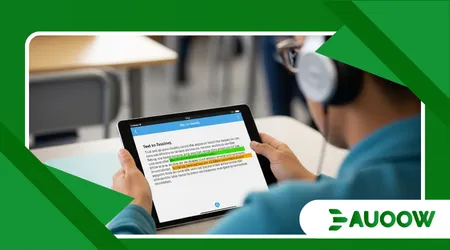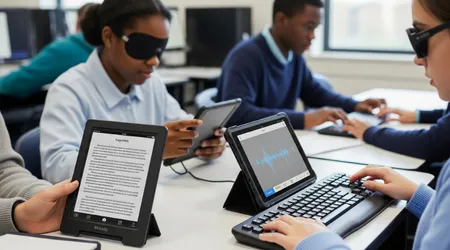Assistive EdTech: Top Tools Helping Students Learn

Assistive EdTech represents the vanguard of inclusive learning, permanently reshaping the educational landscape for students with diverse needs.
This specialized field of technology ensures that physical, cognitive, and sensory differences no longer constitute insurmountable barriers to academic achievement.
The promise of true inclusive education now finds its most potent expression in these transformative digital tools, moving beyond mere accommodation to actual empowerment.
We are witnessing an unprecedented convergence of artificial intelligence and educational design, making personalized learning a reality rather than a pedagogical ideal.
This technological evolution allows every student to access, interact with, and demonstrate knowledge on their own terms, fostering equitable environments.
Examining the current market reveals several innovative tools setting new standards for accessibility.
What is the Critical Role of Assistive EdTech in Modern Inclusive Education?
The primary function of Assistive EdTech is bridging the gap between a student’s ability and the demands of the learning environment.
It’s about adaptation, providing a personalized pathway to master curriculum content for every single learner. Without these tools, many students would struggle to access the curriculum designed for the “average” learner.
A student with dyslexia, for example, may possess brilliant comprehension skills but face an arduous process of decoding text on the page.
Assistive EdTech intervenes here, converting visual information into auditory input. This simple yet profound shift allows the student to focus their cognitive energy on learning, not on struggling with a fundamental access challenge.
This approach aligns perfectly with the modern understanding of Universal Design for Learning (UDL), which emphasizes flexible methods of engagement, representation, and expression.
By strategically deploying technology, educators dismantle systemic barriers and create genuinely accessible classrooms from the start.
++ Equity vs Equality in Schools: What Policies Actually Work?
Why Do Personalized Learning Technologies Matter for Diverse Students?
Personalized learning is the core benefit delivered by sophisticated Assistive EdTech platforms.
These tools continuously gather data on a student’s progress, adjusting the pace, format, and complexity of content in real-time. This dynamic adaptation is impossible in a traditional classroom setting.
The adaptive nature of the software ensures tasks remain within a student’s “zone of proximal development,” providing challenges that lead to growth without inducing frustration.
For a student with Attention-Deficit/Hyperactivity Disorder (ADHD), for instance, an adaptive platform can break down complex assignments into smaller, manageable chunks with built-in reminders.
This level of customization fundamentally boosts self-efficacy, making students feel capable and in control of their educational journey.
It transforms the learning experience from a restrictive, one-size-fits-all model into an empowering, tailored opportunity for success.

How Do Text-to-Speech and Speech-to-Text Tools Revolutionize Access?
The dual technologies of text-to-speech (TTS) and speech-to-text (STT) are perhaps the most ubiquitous and powerful forms of Assistive EdTech in use today.
They fundamentally change how students consume and produce information, effectively giving them an academic voice.
Also read: Why Inclusive Education Is Key to Achieving the SDGs by 2030
What Makes Modern TTS Voices More Effective for Learning?
Modern TTS tools, powered by advanced neural networks, no longer sound robotic; they feature human-like intonation, pacing, and even emotional context.
This natural-sounding delivery significantly reduces listener fatigue, helping students maintain focus during long reading assignments. The ability to customize voice type and reading speed is an essential feature.
Leading TTS applications now integrate seamlessly with learning management systems (LMS) and web browsers, instantly reading digital textbooks, articles, and exam questions aloud.
This multimodal presentation seeing the words highlighted while hearing them spoken proves incredibly effective for reading comprehension across diverse learner profiles.
A high school student with visual impairment can use a TTS browser extension to listen to the entire content of a virtual chemistry lab manual.
The tool allows them to navigate equations and complex diagrams using audio cues and customized shortcut keys, fully participating in the class activity.
Read more: Sensory Play: Enhancing Learning for Students with Special Needs
How Does STT Empower Students with Motor or Writing Challenges?
Speech-to-text technology gives students who struggle with handwriting or typing a direct line from thought to digital output.
By simply articulating their thoughts, they bypass the physical challenge of writing, ensuring their intellectual capacity is accurately reflected in their work. This is a game-changer for many.
The accuracy and speed of contemporary STT engines, including tools integrated into operating systems, have reached a point where they handle complex academic language and diverse accents remarkably well.
This capability transforms writing assignments, turning them into exercises in composition and critical thinking rather than struggles with motor skills.
Consider a student with dysgraphia: they can use STT to dictate a detailed, well-structured essay in minutes, focusing on argument development rather than the mechanics of transcription.
This allows their teacher to assess the student’s actual knowledge of the subject matter, providing a more accurate and equitable evaluation.
Which Top Tools Are Shaping the Future of Assistive EdTech in 2025?
The current landscape of Assistive EdTech is dynamic, with tools specializing in various needs, from organization to content accessibility.
Selecting the right platform is critical for successful integration and maximum student benefit.
How Are AI-Driven Systems Personalizing Content Delivery?
Artificial Intelligence is driving a new generation of Assistive EdTech tools that can generate personalized summaries, create targeted practice quizzes, or even translate complex texts into simpler language.
This AI layer allows the content itself to adapt to the learner’s needs, not just the delivery method.
One major platform, for example, uses AI to analyze student performance in real-time and recommend specific, brief video tutorials or interactive exercises when it detects a knowledge gap.
This preemptive intervention keeps students from falling behind, addressing learning struggles immediately. This is proactive, not reactive, support.
These intelligent systems are also assisting teachers by automating the creation of differentiated materials.
This saves educators invaluable time, allowing them to focus on direct student support and the higher-level strategy of lesson planning. The machine handles the repetitive customization, the teacher provides the human touch.
What New Visual and Organizational Tools Enhance Executive Function?
Executive function difficulties issues with planning, organization, and memory affect many students. Visual and organizational Assistive EdTech tools help externalize these cognitive processes, making abstract tasks concrete and manageable.
Digital mind-mapping applications, for example, allow students to structure projects visually.
Digital planners and reminder apps, specifically designed for students, integrate seamlessly with course calendars and assignment deadlines.
They provide personalized alerts and break down major projects into sequential, timed steps, teaching essential time-management skills alongside academics.
A university student with autism spectrum disorder uses a visual schedule app that integrates with their institution’s LMS.
The app provides a checklist for their morning routine, a visual map to their lecture hall, and a clear, distraction-free interface for notetaking during class. This highly structured environment significantly reduces anxiety and boosts focus.
Analyzing the Impact and Adoption of Assistive EdTech
The effectiveness of Assistive EdTech is not merely anecdotal; verifiable data confirms its transformative impact on student outcomes.
This technology is quickly moving from optional add-on to mandatory component of the inclusive classroom.
According to a 2024 analysis published by the Special Needs Education Technology Market Report, the global Special Needs Education Technology market size reached USD 6.1 billion in 2024 and is projected to expand significantly, demonstrating a robust momentum driven by heightened awareness of inclusive education.
This financial growth reflects a systemic commitment.
| Assistive Technology Category | Primary Learning Challenge Addressed | Example Tool Functionality | Measured Student Benefit |
| Text-to-Speech (TTS) | Reading disabilities (Dyslexia), Visual impairment | Reads digital text aloud with synchronized highlighting. | Improved reading speed and comprehension. |
| Speech-to-Text (STT) | Dysgraphia, Physical writing limitations, Mobility issues | Converts spoken word directly into typed text. | Higher quality written output and reduced frustration. |
| Adaptive Learning Platforms | Varying paces of learning, Knowledge gaps | Adjusts content difficulty and pathways in real-time. | Personalized mastery and increased self-efficacy. |
How can we ethically justify an educational system that withholds these proven tools from students who need them most? Assistive EdTech is not a crutch; it’s a ramp.
A crutch is a temporary support used to manage an injury, but a ramp is a permanent, structural change that makes a building (the education system) fully accessible for everyone. We are building the ramps.
Conclusion: Securing Equity Through Technology
Assistive EdTech is unequivocally the cornerstone of educational equity in the 21st century.
The sophisticated, AI-driven tools available in 2025 offer unprecedented opportunities to personalize learning, tear down academic barriers, and empower every student, regardless of their challenges.
From advanced TTS to adaptive content delivery, these technologies ensure that intellectual potential is never stifled by accessibility issues. Adopting these tools is not just an educational trend; it’s an ethical imperative.
We must continue to champion the ethical integration of Assistive EdTech in every classroom.
What challenges has your school or district faced in implementing these top tools? Share your experience and solutions in the comments below.
Frequently Asked Questions (FAQ)
Does Assistive EdTech replace the need for Special Education teachers?
Absolutely not. Assistive EdTech acts as a powerful tool for the teacher.
The technology manages content delivery and basic accommodation, but the teacher remains essential for providing emotional support, high-level instruction, pedagogical guidance, and interpreting the data produced by the tools.
Are these top Assistive EdTech tools expensive for schools?
Costs vary widely. Many operating systems (like Google and Microsoft) now embed high-quality assistive features for free or low cost within their standard educational licenses.
Specialized adaptive platforms require a subscription, but schools can often negotiate volume pricing or secure government funding earmarked for special education technology.
How do students learn to use these new and complex tools effectively?
Successful adoption requires explicit instruction. Students need dedicated time and training to master the features of Assistive EdTech tools.
Teachers, parents, and specialists should collaboratively integrate the technology into the student’s daily routine until it becomes a seamless, invisible part of their learning process.
Can Assistive EdTech help students without formally identified disabilities?
Yes. Many features, such as text highlighting, digital organization, and visual mind-mapping, benefit all students by promoting better study skills and differentiated learning styles. What is essential for some is often beneficial for everyone.
